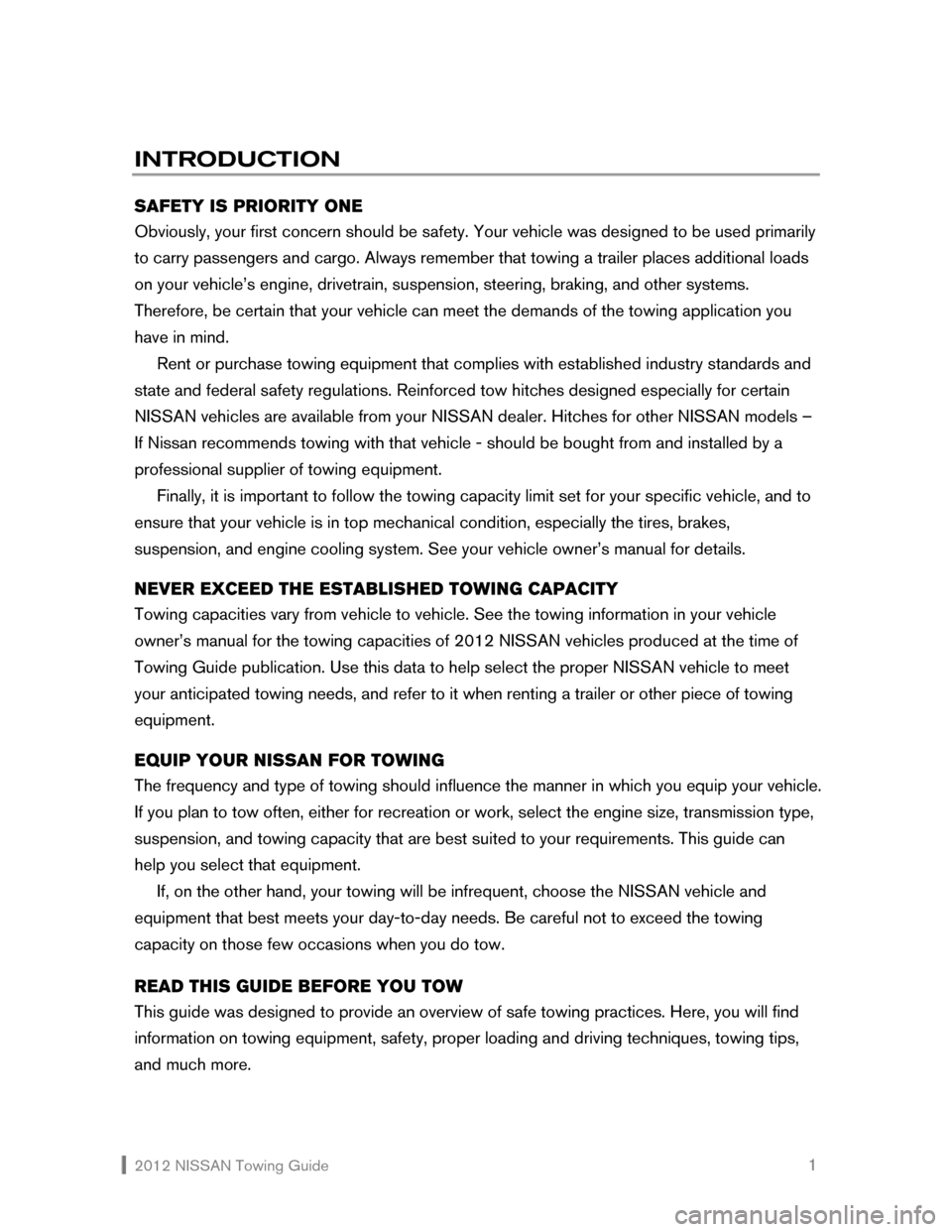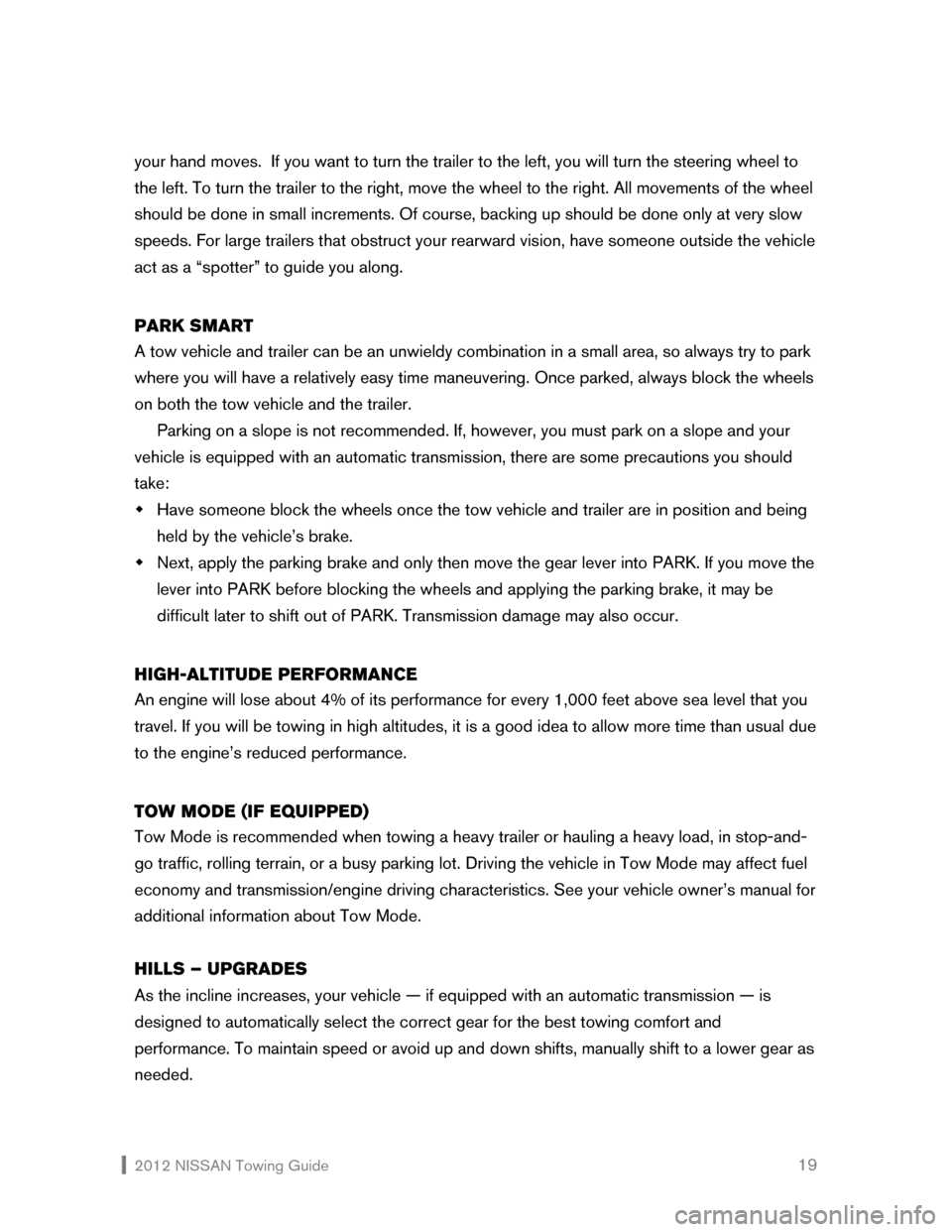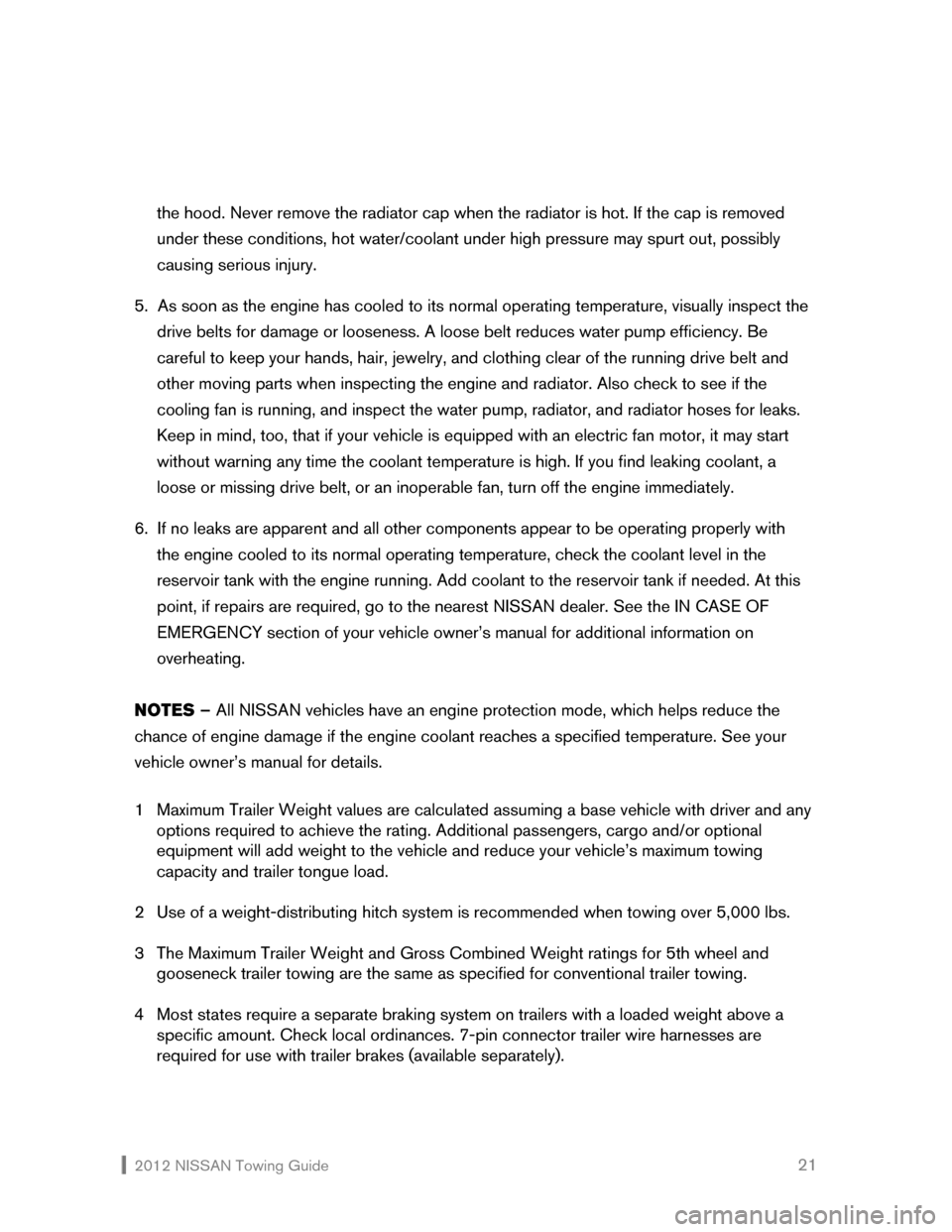ECO mode NISSAN XTERRA 2012 N50 / 2.G Towing Guide
[x] Cancel search | Manufacturer: NISSAN, Model Year: 2012, Model line: XTERRA, Model: NISSAN XTERRA 2012 N50 / 2.GPages: 27, PDF Size: 2.93 MB
Page 2 of 27

2012 NISSAN Towing Guide 1
INTRODUCTION
SAFETY IS PRIORITY ONE
Obviously, your first concern should be safety. Your vehicle was designed to be used primarily
to carry passengers and cargo. Always remember that towing a trailer places additional loads
on your vehicle’s engine, drivetrain, suspension, steering, braking, and other systems.
Therefore, be certain that your vehicle can meet the demands of the towing application you
have in mind.
Rent or purchase towing equipment that complies with established industry standards and
state and federal safety regulations. Reinforced tow hitches designed especially for certain
NISSAN vehicles are available from your NISSAN dealer. Hitches for other NISSAN models –
If Nissan recommends towing with that vehicle - should be bought from and installed by a
professional supplier of towing equipment.
Finally, it is important to follow the towing capacity limit set for your specific vehicle, and to
ensure that your vehicle is in top mechanical condition, especially the tires, brakes,
suspension, and engine cooling system. See your vehicle owner’s manual for details.
NEVER EXCEED THE ESTABLISHED TOWING CAPACITY
Towing capacities vary from vehicle to vehicle. See the towing information in your vehicle
owner’s manual for the towing capacities of 2012 NISSAN vehicles produced at the time of
Towing Guide publication. Use this data to help select the proper NISSAN vehicle to meet
your anticipated towing needs, and refer to it when renting a trailer or other piece of towing
equipment.
EQUIP YOUR NISSAN FOR TOWING
The frequency and type of towing should influence the manner in which you equip your vehicle.
If you plan to tow often, either for recreation or work, select the engine size, transmission type,
suspension, and towing capacity that are best suited to your requirements. This guide can
help you select that equipment.
If, on the other hand, your towing will be infrequent, choose the NISSAN vehicle and
equipment that best meets your day-to-day needs. Be careful not to exceed the towing
capacity on those few occasions when you do tow.
READ THIS GUIDE BEFORE YOU TOW
This guide was designed to provide an overview of safe towing practices. Here, you will find
information on towing equipment, safety, proper loading and driving techniques, towing tips,
and much more.
Page 20 of 27

2012 NISSAN Towing Guide 19 your hand moves. If you want to turn the trailer to the left, you will turn the steering wheel to
the left. To turn the trailer to the right, move the wheel to the right. All movements of the wheel
should be done in small increments. Of course, backing up should be done only at very slow
speeds. For large trailers that obstruct your rearward vision, have someone outside the vehicle
act as a “spotter” to guide you along.
PARK SMART
A tow vehicle and trailer can be an unwieldy combination in a small area, so always try to park
where you will have a relatively easy time maneuvering. Once parked, always block the wheels
on both the tow vehicle and the trailer.
Parking on a slope is not recommended. If, however, you must park on a slope and your
vehicle is equipped with an automatic transmission, there are some precautions you should
take:
�Š Have someone block the wheels once the tow vehicle and trailer are in position and being
held by the vehicle’s brake.
�Š Next, apply the parking brake and only then move the gear lever into PARK. If you move the
lever into PARK before blocking the wheels and applying the parking brake, it may be
difficult later to shift out of PARK. Transmission damage may also occur.
HIGH-ALTITUDE PERFORMANCE
An engine will lose about 4% of its performance for every 1,000 feet above sea level that you
travel. If you will be towing in high altitudes, it is a good idea to allow more time than usual due
to the engine’s reduced performance.
TOW MODE (IF EQUIPPED)
Tow Mode is recommended when towing a heavy trailer or hauling a heavy load, in stop-and-
go traffic, rolling terrain, or a busy parking lot. Driving the vehicle in Tow Mode may affect fuel
economy and transmission/engine driving characteristics. See your vehicle owner’s manual for
additional information about Tow Mode.
HILLS – UPGRADES
As the incline increases, your vehicle — if equipped with an automatic transmission — is
designed to automatically select the correct gear for the best towing comfort and
performance. To maintain speed or avoid up and down shifts, manually shift to a lower gear as
needed.
Page 22 of 27

2012 NISSAN Towing Guide 21
the hood. Never remove the radiator cap when the radiator is hot. If the cap is removed
under these conditions, hot water/coolant under high pressure may spurt out, possibly
causing serious injury.
5. As soon as the engine has cooled to its normal operating temperature, visually inspect the
drive belts for damage or looseness. A loose belt reduces water pump efficiency. Be
careful to keep your hands, hair, jewelry, and clothing clear of the running drive belt and
other moving parts when inspecting the engine and radiator. Also check to see if the
cooling fan is running, and inspect the water pump, radiator, and radiator hoses for leaks.
Keep in mind, too, that if your vehicle is equipped with an electric fan motor, it may start
without warning any time the coolant temperature is high. If you find leaking coolant, a
loose or missing drive belt, or an inoperable fan, turn off the engine immediately.
6. If no leaks are apparent and all other components appear to be operating properly with
the engine cooled to its normal operating temperature, check the coolant level in the
reservoir tank with the engine running. Add coolant to the reservoir tank if needed. At this
point, if repairs are required, go to the nearest NISSAN dealer. See the IN CASE OF
EMERGENCY section of your vehicle owner’s manual for additional information on
overheating.
NOTES – All NISSAN vehicles have an engine protection mode, which helps reduce the
chance of engine damage if the engine coolant reaches a specified temperature. See your
vehicle owner’s manual for details.
1 Maximum Trailer Weight values are calculated assuming a base vehicle with driver and any
options required to achieve the rating. Additional passengers, cargo and/or optional
equipment will add weight to the vehicle and reduce your vehicle’s maximum towing
capacity and trailer tongue load.
2 Use of a weight-distributing hitch system is recommended when towing over 5,000 lbs.
3 The Maximum Trailer Weight and Gross Combined Weight ratings for 5th wheel and
gooseneck trailer towing are the same as specified for conventional trailer towing.
4 Most states require a separate braking system on trailers with a loaded weight above a
specific amount. Check local ordinances. 7-pin connector trailer wire harnesses are
required for use with trailer brakes (available separately).